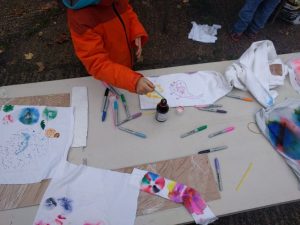by Roger Gossett
A little bit about me (really us – it includes my wife Isabella Gossett). Our children, Natasha and Jason, were born in the early 80’s. When it was time for them to go to school a little bit of visiting local primaries made me, born in the area around 30 years previously, feel that time had stood still. The classrooms looked identical to what I remember, some were portacabins in the playground. Everyone was shut away, in their classroom, for the majority of the day. Just as I remembered school around 25 years earlier.

So, rather than go back in time, what to do? Well, I’m not sure how I heard of it but I started to explore home education. Back in the mid 80’s home ed was not widespread, the main organisation was Education Otherwise – they were helpful and could put home eders in touch with each other. We were also guided by John Holts book How Children Learn and of course the writing of A S Neill. In addition, in those days, the local Education Authority required you to apply for permission to home educate and assigned an inspector to ensure the children were getting an education at least equivalent to what they would have got had they been at school. That was good enough for us and both Natasha and Jason were home educated for the duration of their Primary years, after which they joined secondary school.
With a background of being home educated it did not come as too much of a surprise when Natasha decided to home educate her first born, Charli. In the almost 30 years from when Natasha turned 5 yr and Charli became 5 yr old, a lot had changed in the home education world. Things were more free: the council no longer sent inspectors to your home and there were many more organisations involved in home education. Enter Free We Grow.
Charli started FWG in Sept 2017, when she was 7 yr old. At that time the facilitators were Sally and Rowan. From the outset it was clear that FWG lived up to its name of Free = Freedom. The children were free to choose the emphasis of their activities via the daily democratic meetings. These formed the basis of an excellent introduction to deciding what was going to be done by taking into consideration the thoughts of all those involved. A real insight for the children into how people differ from one another, and that from a young age we do not necessarily all have the same opinions; but, everyone’s opinion does matter.
One of the big advantages of the FWG site is Dacres Wood. It has unspoilt woodland and ponds and is filled with wildlife: foxes, cats, birds, frogs, ducks, and insects to name just a few. The children are free to explore all that Dacres wood has to offer and are guided in this exploration by the presence of at least one facilitator. How different this is to my own memories of primary school and how much more akin it is to Natasha and Jason’s own experiences at Charli’s age. Although we did not have a wood on our doorstep we would regularly go to Epping Forest, Wanstead Flats, and local parks.
Not only did the children have access to Dacres Wood but they would also go on trips organised by the facilitators. One of the first I remember was a trip to Ravensbourne river in conjunction with Thames 21. On this trip the children got to walk in the river and were led by a knowledgeable guide from Thames 21. In addition, both facilitators and parent helpers were present to ensure the safety of all the children. This was an excellent way to help build their confidence in and around water and to expand their knowledge of nature. It was a pleasure to see them enjoying themselves and to share conversation over a picnic style lunch.
Not only do the children get a chance to decide how they are going to spend their day, the facilitators provided opportunities for parents and carers to join in and provide experiences that the children might enjoy. Of course, the children get the final say as to whether they take part or not and one that I really enjoyed providing was to explore the concept of colour. We did this in many ways and one that I think went down really well was the making of tie-and-dye clothing. We did it in such a way that the clothing soaked up the colour gradually and, in so doing, became split into its component colours – basically we created rainbows from whatever pattern we used to decorate the clothing. This led us into a desire for a deeper understanding of what colour was and that became the topic of another activity around the electromagnetic spectrum.
The idea of one activity leading to a desire for a deeper understanding is what I think is at the heart of our curiosity. Children are natural born scientists: they love to explore, they are incredibly observant and love to ask questions – they are not satisfied until what they explore makes sense to them.
Finally, I feel that the facilitators at FWG have developed an atmosphere for learning that allows and encourages all children to develop as individuals through an exploration of what is dear to them. Essentially, the facilitators have not imposed anything upon the children. What they have done is to be empathetic with each individual and, in so doing, bring out the best in the learner’s own way of exploring the world. To me this is what teaching is all about – not transferring information to a blank page, instead it is opening-up the mind of the learner to whatever it is that captures their interest. And, having facilitated this to happen, further encouraging the development of the interest until the learner is satisfied.
Roger Gossett
11 September 2022
